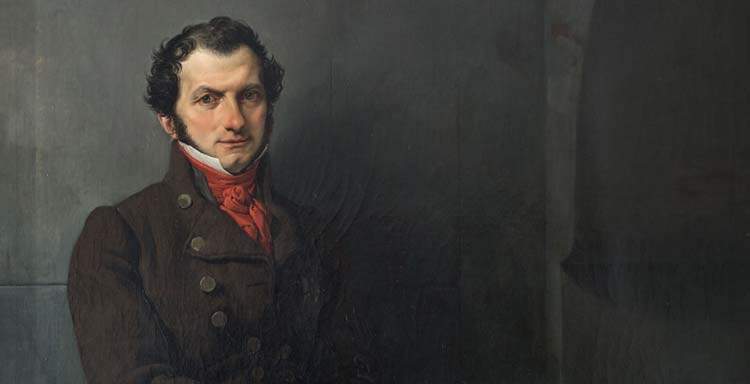Start 2023 with a bang for the Uffizi: purchased masterpiece by Francesco Hayez
The Uffizi ’s 2023 begins with important news: the Florentine museum has acquired a masterpiece by Francesco Hayez (Venice, 1791 - Milan, 1882), Portrait of Count Colonel Francesco Teodoro Arese Lucini in Prison, an 1828 work by the great exponent of Romanticism, and among the most important paintings of Risorgimento painting. The painting depicts Francesco Teodoro Arese Lucini (Milan 1778-1836), a Napoleonic soldier later involved in the Risorgimento uprisings, in his cell in the Spielberg Prison, and from today it can be seen in the museum, at the top of the Lorraine staircase, while an exhibition tour of several museums in Tuscany will begin in the spring.
The outfit is of military fashion, but of the “comfortable” kind, the tie is perfectly knotted under the starched collar of the shirt, the gaze is frankly directed at the observer. But all the squalor of the prison remains, from the rough walls of the cell, the unmade bed, the crate used as a seat, the shackles clutching the ankles, underscoring the prisoner’s very harsh condition.This is how Francesco Hayez in the late 1820s portrayed Arese Lucini, in a painting that has become famous both for its highly original story and for its intrinsic expressive power.
The acquisition of Hayez’s Portrait of Count Colonel Francesco Teodoro Arese Lucini in Prison thus allows the Uffizi Galleries to enrich its holdings with a fundamental work, not only for its pictorial value, but also for its strong historical and political significance in relation to the Risorgimento uprisings. Indeed, the ability of Hayez, among the greatest interpreters of Italian and international Romanticism, to express, together, the hopes and disappointments of the Italian Risorgimento emerges in this painting.

The oil on canvas is characterized by its revolutionary charge: it was Arese Lucini himself, a “noble gentleman,” as Hayez called him, who, as a member of the aristocracy, wanted to break with the plastered conventions of portraiture by choosing to be portrayed in chains (although at the time the painting was executed the sentence had actually already ended). It was, in all likelihood, an attempt at social redemption, which the count wanted to entrust to the brilliant touch of the Lombard painter. A former Napoleonic colonel, Count Arese had participated in the Risorgimento uprisings of 1820-21, ending up on trial and being sentenced to death two years later. The death sentence, however, was converted to three years’ imprisonment in the grim Austrian penitentiary on the Spielberg (the same one in which Silvio Pellico wrote his famous diary, Le mie Prigioni), in the mountains of Brno, after, during the trial, the count-colonel had told the court everything he knew about the other accused, justifying himself by his alleged inability to lie.
It was also by having himself portrayed as a ’prison martyr’ by Hayez, that Arese-Lucini succeeded, with great communicative effectiveness, in showing the public an image of his conditions of imprisonment, such that all shadows and doubts about his own trial behavior were dispelled. The painting’s protagonist was then a passionate collector and generous patron. In the course of his life, in fact, Arese Lucini had the opportunity to acquire other masterpieces by Hayez, such as the first lost version of The Count of Carmagnola as he is about to be led to torture, recommends his family to his friend Gonzaga, the last scene of Alessandro Manzoni’s tragedy, exhibited at Brera in 1821, and in 1832 the Portrait of Carlo Prayer in the character of Alp (The Venetian Renegade).
“Arese, convicted of taking part in the failed anti-Austrian uprisings of 1820-21,” comments Uffizi director Eike Schmidt, “revealed the names of the conspirators and Federico Confalonieri, professing an impossibility to lie that certainly saved him from the death sentence, but not from years of harsh imprisonment that seriously undermined his health. The painting admirably summarizes the Count’s story and motives, but above all it offers Francesco Hayez, the greatest painter of Italian Romanticism, the chance to measure himself against the character’s psychology and to offer one of the highest proofs of his pictorial production. The Uffizi Galleries are thus enriched with a masterpiece reproduced in the most important texts on the nineteenth century.”
 |
| Start 2023 with a bang for the Uffizi: purchased masterpiece by Francesco Hayez |
Warning: the translation into English of the original Italian article was created using automatic tools. We undertake to review all articles, but we do not guarantee the total absence of inaccuracies in the translation due to the program. You can find the original by clicking on the ITA button. If you find any mistake,please contact us.




























